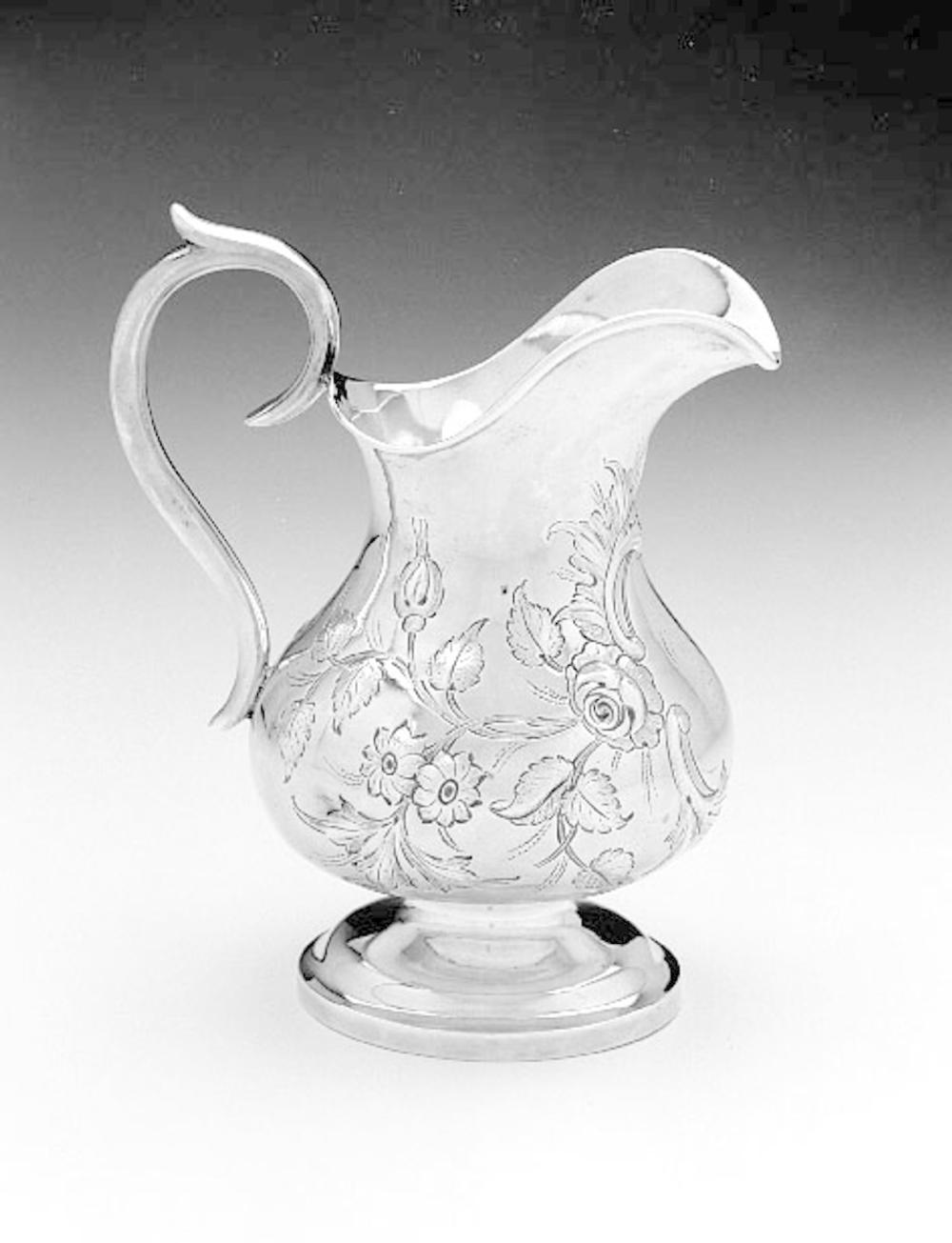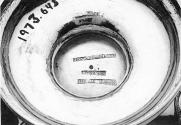Advanced Search
Cream pitcher
Jones, Ball & Co. (1852–1854)
George B. Jones (1815–1875)
Nathaniel C. Poor (1808–1895)
True M. Ball (American, 1815–1890)
Benjamin Shreve (1813–1896)
Seth E. Brown (American, 1821–1884)
John Damon (American, active about 1852–1854)
George B. Jones (1815–1875)
Nathaniel C. Poor (1808–1895)
True M. Ball (American, 1815–1890)
Benjamin Shreve (1813–1896)
Seth E. Brown (American, 1821–1884)
John Damon (American, active about 1852–1854)
about 1852
Object Place: Boston, Massachusetts, United States
Medium/Technique
Silver; Pure Coin
Dimensions
15.5 x 12.6 x 9.6 cm (6 1/8 x 4 15/16 x 3 3/4 in.)
Credit Line
Gift of the Estate of Alice Brooks Spark Wendling
Accession Number1973.645
NOT ON VIEW
CollectionsAmericas
ClassificationsSilver hollowware
This pitcher and two other pieces from the same donor (cat. no. 232) belonged to Mary Caroline (“Carrie”) Brooks Champney and her husband, Benjamin Champney, an artist known in Boston for his landscapes and portrait work. The artist said of his wife that she was born in “Indiana but of good New England stock.” He also noted in his biography that “Mrs. Champney is very fond of flowers,” a sentiment confirmed by the exuberant floral decoration of the silverware in her possession.
Available from the firm from at least 1848 to 1858, this graceful pear-shaped cream pitcher could be purchased in several versions: with floral motif but supported by three paw feet or with an acorn-and-oakleaf pattern, either on paw feet or with a round and domed foot. Until more is known about the relationships between members of the luxury metals trade, it is difficult to distinguish between maker and retailer. From the beginning, Jones and partners advertised themselves as retailers of both local and imported wares, though they may have manufactured some items as well.
By the 1850s, the company was nationally known, and partners Jones, Ball & Poor built a new “state-of-the-art” store at 226 Washington Street. When True M. Ball (who replaced Samuel S. Ball by 1839) left the firm in the early 1850s, the company reformed, and “Shreve and Brown” was listed after George B. Jones in the company name. George B. retired in 1859, and Brown remained with Shreve until 1862, when the firm reformed once again, and Henry B. Stanwood became Shreve’s partner (see cat. no. 231). Benjamin Shreve and Seth E. Brown were associated with the firm (Jones, Ball & Co.) by 1852, and by the mid-1850s, the two men were included in the company name of Jones, Shreve, Brown & Co. (see cat.no. 229).
When George B. Jones retired in 1858, Shreve and Brown continued at the head of the firm. When Brown left in 1862, Henry B. Stanwood joined the firm; he remained until his death in 1869. In 1870 Charles H. Crump and George P. Low joined Benjamin Shreve, and the company became known as Shreve, Crump & Low (1870 – present).
This text has been adapted from "Silver of the Americas, 1600-2000," edited by Jeannine Falino and Gerald W.R. Ward, published in 2008 by the MFA. Complete references can be found in that publication.
Available from the firm from at least 1848 to 1858, this graceful pear-shaped cream pitcher could be purchased in several versions: with floral motif but supported by three paw feet or with an acorn-and-oakleaf pattern, either on paw feet or with a round and domed foot. Until more is known about the relationships between members of the luxury metals trade, it is difficult to distinguish between maker and retailer. From the beginning, Jones and partners advertised themselves as retailers of both local and imported wares, though they may have manufactured some items as well.
By the 1850s, the company was nationally known, and partners Jones, Ball & Poor built a new “state-of-the-art” store at 226 Washington Street. When True M. Ball (who replaced Samuel S. Ball by 1839) left the firm in the early 1850s, the company reformed, and “Shreve and Brown” was listed after George B. Jones in the company name. George B. retired in 1859, and Brown remained with Shreve until 1862, when the firm reformed once again, and Henry B. Stanwood became Shreve’s partner (see cat. no. 231). Benjamin Shreve and Seth E. Brown were associated with the firm (Jones, Ball & Co.) by 1852, and by the mid-1850s, the two men were included in the company name of Jones, Shreve, Brown & Co. (see cat.no. 229).
When George B. Jones retired in 1858, Shreve and Brown continued at the head of the firm. When Brown left in 1862, Henry B. Stanwood joined the firm; he remained until his death in 1869. In 1870 Charles H. Crump and George P. Low joined Benjamin Shreve, and the company became known as Shreve, Crump & Low (1870 – present).
This text has been adapted from "Silver of the Americas, 1600-2000," edited by Jeannine Falino and Gerald W.R. Ward, published in 2008 by the MFA. Complete references can be found in that publication.
DescriptionThe pitcher has a bulbous body, narrow neck, and cast circular molded foot. A scrolled handle with grip is attached opposite the lip. The body of the pitcher is decorated with stippled foliate repouseé-chased decoration that extends around the entire body. The decoration is not symetrical relative to the handle or the cartouche but rendered in a naturalistic manner.
Marks
"Jones, Ball & Co./ Boston / Pure Coin" are each stamped within rectangles on the base.
Ada Mark * F4751
Ada Mark * F4751
Inscriptions" Carrie / from a / Friend. " engraved within a cartouche.
ProvenanceMary Caroline Brooks (1829 – 1876) and Benjamin Crackbone Champney (1817 – 1907), m. 1853 in Woburn, Massachusetts; to their granddaughter Alice Brooks Sparks Wendling (d. 1973), the donor.



